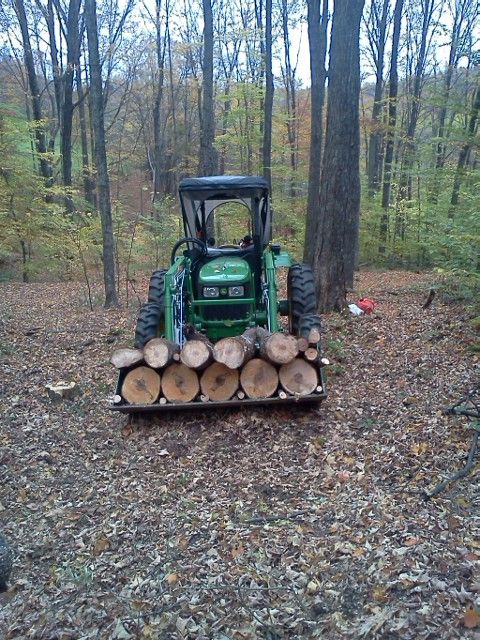You are using an out of date browser. It may not display this or other websites correctly.
You should upgrade or use an alternative browser.
You should upgrade or use an alternative browser.
Theory of rear ballast?
- Thread starter jodebg
- Start date
- Views: 22958
/ Theory of rear ballast?
#71
Eric Salop
Elite Member
Stability is obviously something you take seriously with that extended wheel track width on your 5045. Guess you have a lot of work on sloping ground.
In addition to preventing tipping, isn't having enough ballast on the back also about easing the forces and so reducing wear on the front axle ?
LD1
Epic Contributor
Stability is obviously something you take seriously with that extended wheel track width on your 5045. Guess you have a lot of work on sloping ground.
In addition to preventing tipping, isn't having enough ballast on the back also about easing the forces and so reducing wear on the front axle ?
Bingo.
Rear counterweight is about more than just having the rear tires stay on the ground. Its about taking weight off the front axle. But if that bucket load of firewood is about the heaviest you ever get (or even a full bucket load of dirt), you simply arent even coming close to your lift capacity. Maybe 1200-1500# is all you are lifting. Therefore your probably not overloading your front axle.
IF I set your total tractor weight to 3500kg, with an even 50/50 weight split (which IMO is probably close counting the tire ballast), it shows you can lift 1000kg (2200#) in the loader and still be 0 in the counterweight column. Probably why you dont have any issues. Since you arent using the loader to its fullest.
vtsnowedin
Elite Member
Stability is obviously something you take seriously with that extended wheel track width on your 5045. Guess you have a lot of work on sloping ground.
In addition to preventing tipping, isn't having enough ballast on the back also about easing the forces and so reducing wear on the front axle ?
I have a hard time finding a flat spot big enough to park on.
Yes certainly when loading heavy stuff a counter weight saves the front axle.
rswyan
Super Star Member
- Joined
- May 12, 2004
- Messages
- 11,467
- Location
- Northeast Ohio
- Tractor
- Kubota B2910, Cub Cadet Pro Z 154S, Simplicity 18 CFC, Cub Cadet 782
Your right front tire looks a tad low there LD ...You need to do more loader work :thumbsup:
Dig out some stumps or find some more big boulders, or lift some large logs with some forks. IF you are able to lift everything you try, you arent trying hard enough.
Only time I never find something I cannot lift is when I am sitting on my backhoe.
View attachment 418492
:laughing:
LD1
Epic Contributor
It was a little low in that pic. Down to ~70psi.
They are supposed to be ~110
They are supposed to be ~110
ovrszd
Epic Contributor
- Joined
- May 27, 2006
- Messages
- 32,246
- Location
- Missouri
- Tractor
- Kubota M9540, Ford 3910FWD, Ford 555A, JD2210
You need to do more loader work :thumbsup:
Dig out some stumps or find some more big boulders, or lift some large logs with some forks. IF you are able to lift everything you try, you arent trying hard enough.
I agree. I hit my relief valve very frequently.
ovrszd
Epic Contributor
- Joined
- May 27, 2006
- Messages
- 32,246
- Location
- Missouri
- Tractor
- Kubota M9540, Ford 3910FWD, Ford 555A, JD2210
I'll throw this wrench into this discussion. Seems like it's about beat the current topic to death.
Rear ballast added behind the rear axle removes weight from the front axle in certain conditions. In other conditions it in fact adds weight to the front axle. Anyone want to try to explain that? :confused2:
Rear ballast added behind the rear axle removes weight from the front axle in certain conditions. In other conditions it in fact adds weight to the front axle. Anyone want to try to explain that? :confused2:
k0ua
Epic Contributor
I'll throw this wrench into this discussion. Seems like it's about beat the current topic to death.
Rear ballast added behind the rear axle removes weight from the front axle in certain conditions. In other conditions it in fact adds weight to the front axle. Anyone want to try to explain that? :confused2:
If you rears still come off of the ground, then all the weight of the tractor including what rear ballast you put on is now borne by the front axle. Not a good situation.
ovrszd
Epic Contributor
- Joined
- May 27, 2006
- Messages
- 32,246
- Location
- Missouri
- Tractor
- Kubota M9540, Ford 3910FWD, Ford 555A, JD2210
If you rears still come off of the ground, then all the weight of the tractor including what rear ballast you put on is now borne by the front axle. Not a good situation.
DING DING DING,,,, James is the winner!!!
Now let the arguments begin......


